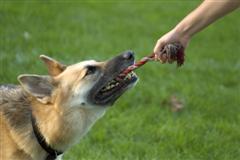This
game has more significance that
other games, because it involves
simulated aggression. The dog
is using it teeth and body and
often growling. Although fun
for both dog and owner, this
game can lead to trouble in
some dogs, and must either be
discontinued, or played by very
strict rules. The cardinal
sign of a dog who needs to stop
or play by the rules, is a dog
who threatens aggression toward
members of the household, or who
is disobedient. Both of
these profiles suggest a dog
who is either untrained, or
beginning to act in a
pushy
way.
|
The test
for tug-of-war games is
whether or not the dog will
"sit" and "give" the toy
upon request. If not,
no more tug-of-war games! |
Recommended rules
for tug of war
 1)
Person starts the game
1)
Person starts the game
Because many canines REALLY
love to play this game, they
may bring the toy to the persona
and indicate a desire to play.
If the owner begins to play,
the dog can begun by controlling
the situation. The dog told
the person what to do. This
gives a subordinate message
that the dog can control the
person.
WHAT TO DO: To play by the
rules, when the dog brings
the toy, instruct the dog
to drop the toy and SIT. Require
a sit-stay for at least 5
seconds. (If the dog cannot
do this, go to basic obedience
school.) After 5 seconds (to
separate incidents in the
dog's mind) pick up
the toy and then release the
dog. If the dog jumps for
the toy prematurely, reinstate
the sit-stay to reinforce
that you are in charge.
2)
Canine teeth to not touch
human skin or clothes
During the tug of war game,
if the dog accidentally (or
intentionally) touches your
skin or clothes with teeth,
take the toy away and stop
the game for at least 30 seconds.
Act bored and ignore the dog
to indicate this is not part
of the game. Withhold both
play and attention while the
dog settles down. Then restart
the game, and stop every time
teeth touch skin or clothes.
Try to give a verbal reprimand
just at the instant of contact
to further clue the dog as
to why the game stops.
3)
Dog must "Give"
at least once during the game.
At any point during the game,
the person should Instruction,
"GIVE" (or other
Instruction the dog already knows)
to instruct the dog to let
go or drop the toy. Once the
toy is released, instruct
the dog to "SIT."
By giving up the toy and sitting
on Instruction, the dog is confirming
an understanding of who is
in charge during this game.
4)
The person always "wins"
at the end.
If the person tires of the
game, and the dog runs off
with the prize, the dog has
won, and in some cases, this
contributes to a dog who mistakenly
thinks they rank above humans
in at least some categories
on some days. This is the
beginning of a problem dog
who might be disobedient,
or aggressive, or anxious.
 The
dogs that want to play the most,
are the dogs who need the rules
the most. For some dogs, tug
of war it their most favorite
thing in the world. If this
is the case, use it as a reward
after a short training session,
where you ask for SIT, then
DOWN, then COME and repeat.
Any Instruction that is followed
communicates that the dog recognizes
the person as a leader, and
this is the basis for a satisfying
and loving relationship.
The
dogs that want to play the most,
are the dogs who need the rules
the most. For some dogs, tug
of war it their most favorite
thing in the world. If this
is the case, use it as a reward
after a short training session,
where you ask for SIT, then
DOWN, then COME and repeat.
Any Instruction that is followed
communicates that the dog recognizes
the person as a leader, and
this is the basis for a satisfying
and loving relationship.